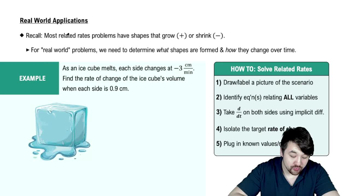Table of contents
- 0. Functions7h 52m
- Introduction to Functions16m
- Piecewise Functions10m
- Properties of Functions9m
- Common Functions1h 8m
- Transformations5m
- Combining Functions27m
- Exponent rules32m
- Exponential Functions28m
- Logarithmic Functions24m
- Properties of Logarithms34m
- Exponential & Logarithmic Equations35m
- Introduction to Trigonometric Functions38m
- Graphs of Trigonometric Functions44m
- Trigonometric Identities47m
- Inverse Trigonometric Functions48m
- 1. Limits and Continuity2h 2m
- 2. Intro to Derivatives1h 33m
- 3. Techniques of Differentiation3h 18m
- 4. Applications of Derivatives2h 38m
- 5. Graphical Applications of Derivatives6h 2m
- 6. Derivatives of Inverse, Exponential, & Logarithmic Functions2h 37m
- 7. Antiderivatives & Indefinite Integrals1h 26m
- 8. Definite Integrals4h 44m
- 9. Graphical Applications of Integrals2h 27m
- 10. Physics Applications of Integrals 2h 22m
4. Applications of Derivatives
Related Rates
Problem 5b
Textbook Question
A rectangular swimming pool 10 ft wide by 20 ft long and of uniform depth is being filled with water.
b. At what rate is the volume of the water increasing if the water level is rising at 1/4ft/min.
 Verified step by step guidance
Verified step by step guidance1
First, identify the dimensions of the swimming pool: it is 10 ft wide and 20 ft long. The depth of the water is changing as the pool is being filled.
The volume of the water in the pool can be expressed as a function of the water depth, h, using the formula for the volume of a rectangular prism: V = length × width × height. In this case, V = 20 × 10 × h.
Since the water level is rising at a rate of 1/4 ft/min, we need to find the rate at which the volume is increasing. This involves differentiating the volume with respect to time, t, using the chain rule.
Differentiate the volume function V = 200h with respect to time t. This gives us dV/dt = 200(dh/dt), where dh/dt is the rate at which the water level is rising.
Substitute the given rate of change of the water level, dh/dt = 1/4 ft/min, into the differentiated equation to find dV/dt, the rate at which the volume is increasing.
 Verified video answer for a similar problem:
Verified video answer for a similar problem:This video solution was recommended by our tutors as helpful for the problem above
Video duration:
3mPlay a video:
Was this helpful?
Key Concepts
Here are the essential concepts you must grasp in order to answer the question correctly.
Volume of a Rectangular Prism
The volume of a rectangular prism, such as a swimming pool, is calculated using the formula V = length × width × height. In this case, the dimensions of the pool are given, and the height corresponds to the water level. Understanding this formula is essential for determining how the volume changes as the water level rises.
Recommended video:

Example 5: Packaging Design
Related Rates
Related rates involve finding the rate at which one quantity changes in relation to another. In this problem, we need to determine how the volume of water in the pool changes as the height of the water increases. This requires applying the concept of derivatives to relate the rates of change of volume and height.
Recommended video:

Intro To Related Rates
Differentiation
Differentiation is a fundamental concept in calculus that deals with finding the rate of change of a function. In this context, we will differentiate the volume formula with respect to time to find the rate at which the volume of water is increasing as the height of the water rises at a specified rate.
Recommended video:

Finding Differentials
Related Videos
Related Practice





